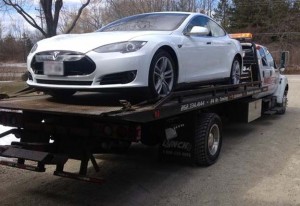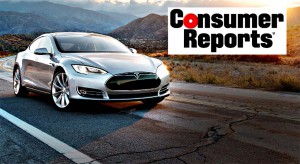Can you ever be both “the best ever” and “below average”? Apparently, you can if you’re the Tesla Model S and the one handing out the superlatives is Consumer Reports magazine.
Barely two months ago, the non-profit publication issued a breathless report announcing that the high-priced battery sedan had effectively broken its rating system, actually scoring more than a perfect 100 points. But on Tuesday, at a presentation to the Automotive Press Association of Detroit, Consumer Reports announced the very same vehicle had major reliability issues, at least according to the owners it surveyed.
“Reliability has moved from ‘Average’ to ‘Below Average,’” said Jake Fisher, CR’s director of automotive testing. As a result, he added, “We’re no longer recommending the Model S.”
That move was the biggest surprise to emerge from the magazine’s annual Automotive Reliability Survey, and while it delivers a clear blow to Tesla, it also creates a cloud around Consumer Reports itself.
(How did other brands score in the latest CR Reliability Report? Click Here to find out.)
According to the 1,400 Tesla owners CR surveyed, the Model S had a variety of issues: squeaks and rattles, electric door handles that failed to operate, leaks, drivetrain problems and faulty chargers.
“As the older vehicles are getting up on miles, we are seeing some where the electric motor needs to be replaced and the onboard charging system won’t charge the battery,” noted CR’s Fisher. “On the newer vehicles, we are seeing problems such as the sunroof not operating properly. Door handles continue to be an issue.”

A number of owners have reported problems with the Model S, including doors that won't open, bad chargers and faulty motors.
Indeed, Consumer Reports discovered how those hideaway handles could pose a problem simply getting into the Model S when it began testing the Tesla earlier this year. In a May article, it described the $127,000 Tesla Model S P85D it was testing as “undriveable,” because of problems with the automatic door handles that are supposed to extend out when someone with the keys approaches the vehicle, didn’t work.
“A new car shouldn’t have problems when you’ve owned it for less than a month,” the magazine said in the website posting. It also noted that CR was “far from the first” to experience that problem, among others.
(Click Herefor that story.)
In the end, the magazine had to call Tesla for help and the start-up automaker sent a flatbed truck out to pick the vehicle up and take it to a dealer for repairs. On the positive side, CR reviewers said they were pleased with the way the service problem was handled. And Khobi Brooklyn, a spokesman for Tesla, points out that in the Automotive Reliability Survey, “customers rate Tesla service as the best in the world.”
Nonetheless, how could an “undriveable” car go on to score 100-plus points and then earn a “Below Average” rating? How could the “best car” CR ever tested lose its “Recommended” endorsement just a few months later?
It all has to do with how Consumer Reports compartmentalizes its tests and surveys. The flurry of praise lavished on the Model S in August was solely based on the way it performed in driving tests, contends Fisher, who added, “That’s not about how the cars hold up” in the real world. That said, critics of CR wonder how the magazine could have overlooked the fact that, at one point it couldn’t even get into the Model S to run those tests.
(Tesla launches new, semi-autonomous Autopilot system. Click Here to learn more.)
The latest announcement has generated plenty of buzz, including extensive criticism of both CR and Tesla. But others believe it is a tempest in a battery-operated teapot.
“With any young company, you have some teething problems. But Tesla customers have such strong belief and loyalty they will excuse some of these problems,” Thilo Koslowski, automotive practice leader at Gartner Inc.. told the Los Angeles Times.“Tesla will fix the issues and learn from them. I don’t think it will hurt the company long term.”
Investors reacted nervously, Tesla stock initially plunging on word of the Consumer Reports downgrade but beginning to rebound on Wednesday morning.
Perhaps disconcertingly, the trendline for the Model S shows that its reliability problems have gotten worse, not better, over the last few years. At 43% worse than average, according to Consumer Reports, the battery-car got a half-black dot on the magazine’s visual rating system. Had it hit 45% it would have gotten the full black dot which has often been a kiss of death for products rated by the magazine.
And CR isn’t alone. TrueDelta, a service that asks owners to rate their reliability experiences, was even tougher on the Model S, noting in a new web posting, “In TrueDelta’s stats the Model S has long (had) well over twice the average repair frequency, even over three times.” But as was the case with Consumer Reports, it noted that Tesla “provided outstanding repair services when needed.”
Nonetheless, the wide range of problems, and the frequency with which they occur, could give many potential buyers reason to reconsider. And the timing couldn’t be worse considering Tesla is just launching its second product line, the Model X SUV. Traditionally, vehicles have higher quality concerns when first reaching market – in this case, about two years behind schedule.
Tesla will have to prove rather quickly that it can overcome its problems – but CR will have to ensure that the Tesla flap doesn’t strain its hard-won credibility.
(From vacuums to electric vehicles? Dyson buys promising battery start-up. Click Here to see what’s in store.)


A BIGGGGGGGGGGG CLOUD !!! I wonder if there was pressure from AUTOMAKERS in this CALL
Consumer Reports panned the Toyota Tacoma even though it had the highest reliability history of any truck on the market and also the highest resale value after 5 years: 50%. My Jetta Wagon lost 2/3 value in 6 years.
CR says the Tacoma roof is too low and the floorboard is too high. Well, for decades, the seat is mounted fairly low to the floorboard and with plenty of legroom under the dash. So it’s just not CR’s opinion of what seat height should be.
My 25 year old “5th generation Hi-Lux” has 256K on the odo meter and it still humming right along. It’s true, it doesn’t have ABS or even airbags. Just don’t get in an accident in it.
In recent years it has become obvious that CR’s reports leave a lot of questions when you can score better than 100% and have an undrivable vehicle. I believe that Consumer Report has lost a lot of credibility amongst car people who know cars well. The numerous problems with the Tesla S are an indication of rushing a product out the door without proper testing and quality checks. Having to replace the entire powertrain is a serious issue.
Trucking an EV hundreds of miles for product defect repair isn’t practical or acceptable for many consumers. As far as service is concerned some think Tesla has good customer service and some think it’s unacceptable. Lawsuits show that Tesla has been forced to buy back defective cars after numerous attempts to fix problems without success. Not being able to actually enter your car for instance is a significant issue.